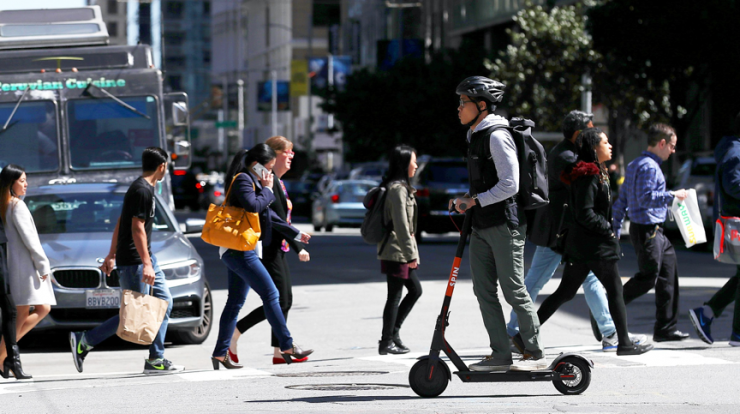There has been staggering growth worldwide in the public use of Personal Mobility Devices (PMDs), especially electric bikes and electric scooters. It has been labelled ‘The Urban Mobility Revolution’. The public reaction to the growth of PMDs has produced an outcry that pedestrian lives are being destroyed by unregulated mobility devices, especially e-scooters. Whilst most countries allow e-bikes on the roads and cycle lanes, e-scooters have generally not been regulated and are often used in congested urban areas. Many believe we are losing the right to go for a walk, although most agree that it is here to stay as a way of coping with traffic in congested cities.
Rapid expansion of personal mobility devices.
We live in exciting times. Technology is advancing at a pace that is mind boggling when compared to our history. One of the often-overlooked by-products of all the exciting gadgets we have today is the advance in battery technology which has contributed to PMDs surging popularity across the world. These battery power devices, especially e-scooters and e-bikes, are becoming common, as environmentally-conscious consumers recognise their potential to save both money and reduce carbon footprints.
Electric scooters have been limited in the past by cumbersome batteries or underperforming lead-acid designs. The advances in lithium-ion technology has offered a smaller, more powerful, longer-lasting option, helping to propel mobility devices to the forefront of personal transportation.
Eco-conscious consumers are driving PMD growth. The potential to save consumers in transportation costs, while simultaneously reducing carbon impact, makes them an easy choice for many. Not only can they be found in urban areas but PMDs are becoming an increasing feature of our country parks and recreation areas.

Global Growth.
Asia-Pacific regions account for the majority of scooter sales on a global scale. In 2016, ninety percent of all global scooter shipments were to this region. European and North American markets have also seen a surge in growth and experts predict markets will become much stronger within the next decade.
One possible factor for this surge in growth is illustrated by US Census Data which describes a dramatic increase in metropolitan populations. It seems that people living in cities are much more likely to have a use for PMDs.
Motor vehicle manufacturers such BMW and Hyundai have also recently entered the market with an e-scooter offering. Hyundai said the idea for adding e-scooters to their vehicles comes from research showing that the ‘Last Mile Mobility’ market in the United States, Europe, and China is expected to grow to $500 billion by 2030.
Singapore.
Singapore, of all the cities in Asia, has recorded the largest growth in adopting PMDs, especially e-scooters. Part of the reason for this has been the cities flat terrain, congested traffic and the appeal to a younger generation.
Homegrown start-up, Telepod, saw the number of trips taken on its e-scooters double in the last three months, while Grab, which piloted its GrabWheels service at the National University of Singapore (NUS) last November, said that the service went on to clock some “40,000km worth of rides” within a month.
Referring to a survey done by NUS, a Grab spokesperson said that “close to eighty per cent of students on campus use our GrabWheels service at least one to four times a week.”
Singapore’s Land Transport Authority (LTA) had been expected to issue PMD-sharing sandbox licences. A regulatory sandbox licence would provide an environment for companies to experiment with PMD services for a certain period and give holders the right to fleets of up to 500 e-scooters, as a precursor to full-fledged, large-scale licensing, by 2019. The regulator has since pushed back its decision until the end of the year, citing safety concerns amid “recent incidents of reckless riding and accidents involving PMDs”.
Whilst there has been strong demand for PMD services there has also been a public backlash. Zachary Tan, a concerned citizen started a public petition which has over 65,000 signatures calling for the the ban of all PMDs due to safety issues. He recently wrote to the Singapore Government calling for Government support following the death of Madam Ong in a PMD related accident. A concerned Singapore citizen responded to Asia Thinkers with the comment that “in Singapore PMDs are being misused and are danger to the public. They should be banned.”
There were 228 reported accidents in Singapore involving PMDs on public paths in 2017 and 2018. Out of these cases, there were 196 with reported injuries.
Manila.
The Philippines is another Asian country with a noticeable increase in demand for PMDs. The increase is not on the same scale as Singapore and is mainly confined to Manila due to poor road conditions and prohibitive cost.
The Electric Scooter Association Philippines commented that they have upward of 2800 members and said the e-scooters market is expanding as Filipinos see it as a great alternative to using public transport to get around the Metro and believe they can help beat Metro Manila traffic because they’re lightweight, portable and, most importantly, environment-friendly. A French diplomat living in Manila commented that he cut his travel time to work from Makati City to Quezon City by almost an hour with his electric scooter.
However, despite their practicality, there is continued public debate on the benefits. Many believe e- scooters are turning into a public nuisance on the road and, with poor road conditions, pose a danger to riders. A spokesman with Manila Transport Department when contacted by Asia thinkers commented that “most e-scooters are lightweight and not meant to go fast, but with the state of the roads and some riders in Metro Manila doing speeds of up to 60kph, stability and safety become big concerns”. He further said “e-scooters are not officially registered and are free to roam without proper registration”. The Land Transport Office has confirmed they will continue to crack down on all PMDs in Manila.
London.
The expansion of PMDs in London has been constrained by what many consider to be antiquated laws. Whilst e-bikes are legal on the roads, riding an electric scooter on the road or pavement is forbidden in the UK. The Government is intending to undertake a traffic review as current mobility laws date back to 1835. A UK Transport Department spokesperson commented that “Safety was at the heart of UK traffic laws and e-scooters were a road safety concern. People who use e-scooters need to be aware it is currently illegal to ride them on the pavement and the road.A spokesman for UK e-scooter club said that they supported the legalisation of e-scooters as way of dealing with congested city traffic and supported legislation in Europe which applied speed limits to e-scooters.
In August this year, campaigners demanding a change to the Road Traffic Act to allow electric scooters on the roads, staged a protest outside Downing Street. Peter Williams the organiser commented that Protesters brought their e-scooters into central London to protest that UK traffic laws were outdated, claiming e-scooters provide an environmentally friendly alternative to cars.
New York.
City Authorities, increasingly concerned about the growth of e-scooters and e-bikes on crowded New York streets, have given into pressure and have made a deal to end the ban on the electric-assisted bicycles and e-scooters across the state, closely following laws passed in other US cities such as Los Angles and Chicago. Previously scooter-share companies like Bird, Lime, Spin, Uber, Lyft and many others, haven’t been able to operate in New York City and other parts of the state, while the scooter craze has run rampant throughout the country.
A New York Transport expert and writer commented to Asia thinkers that it was important to view the recent changes as freeing people from traffic congestion and rather than transport authorities clamping down on PMDs that should continue to find ways of to harness them and improve urban mobility in a safe environment.
The new rules would allow people, age eighteen and above, to ride electric motorised bicycles and scooters in New York City, but ban riders from using the devices on sidewalks. Manhattan has been carved out as an off-limits section to scooter share companies to minimise congestion but owners with their own e-scooters can now ride those legally in Manhattan.

Regulation and safety.
The Associated Press reports that in Europe, since January 2018, at least eleven electric scooter riders have died in road traffic accidents. There are many concerns around the safety of PMDs but especially e-scooters travelling on roads and footpaths. Critics point out that they do not have a proper suspension system, so running them over bumps and cracks on the road is dangerous and could easily cause a rider to lose his balance. The absence of side mirrors, lights and helmets are another safety concern. A further point of concern amongst many, is the behaviour of some riders, weaving through traffic on the road and pedestrians on the sidewalks.
As with any emerging technology, regulators are faced with emerging challenges. Scooters elicit the full range of emotions, from curiosity to skepticism, from joy to loathing.
In Singapore, the government recently adopted regulations that all but killed scooters as a viable commuting tool. Despite the popularity of scooters, a spate of high-profile accidents has seen the Government pass the Active Mobility Act (AMA). The AMA contains a set of rules and code of conduct for cyclists, and riders of personal mobility devices (PMDs), power-assisted bicycles (PABs) and personal mobility aids (PMAs) to ensure safer journeys for all on public paths. E-scooters must now be registered with a safety certification in order to ride on public footpaths. In Manila and London, transport authorities are struggling to deal with the growth of PMDS. Authorities are reviewing proposed legislation and at the same time continuing to crack down on unlicensed PMDs, but in many cases have yet to implement a frame work to govern safety and usage.
Other regions around the world are adopting a more progressive attitude to these personal mobility vehicles. For example, California granted “electrically motorised boards” (including electric scooters but not electric skateboards) legal access on the sidewalks and highways. In Paris and increasingly around Europe, electric scooters are legally defined in terms of speed. Electric kick-scooters are legal on the pavement up to 6kph (walking pace) and up to 25kph on the cycle lane.
The power of electric scooters to transform one’s lifestyle is tremendous. Scooters simplify commutes to work, slash through monthly transportation costs and help improve the environment at the same time! Quality electric scooters are more available than ever before and are quickly spreading in popularity across the globe. Countries will need to monitor and continue to adapt their laws to ensure the safety of both riders and pedestrians.

